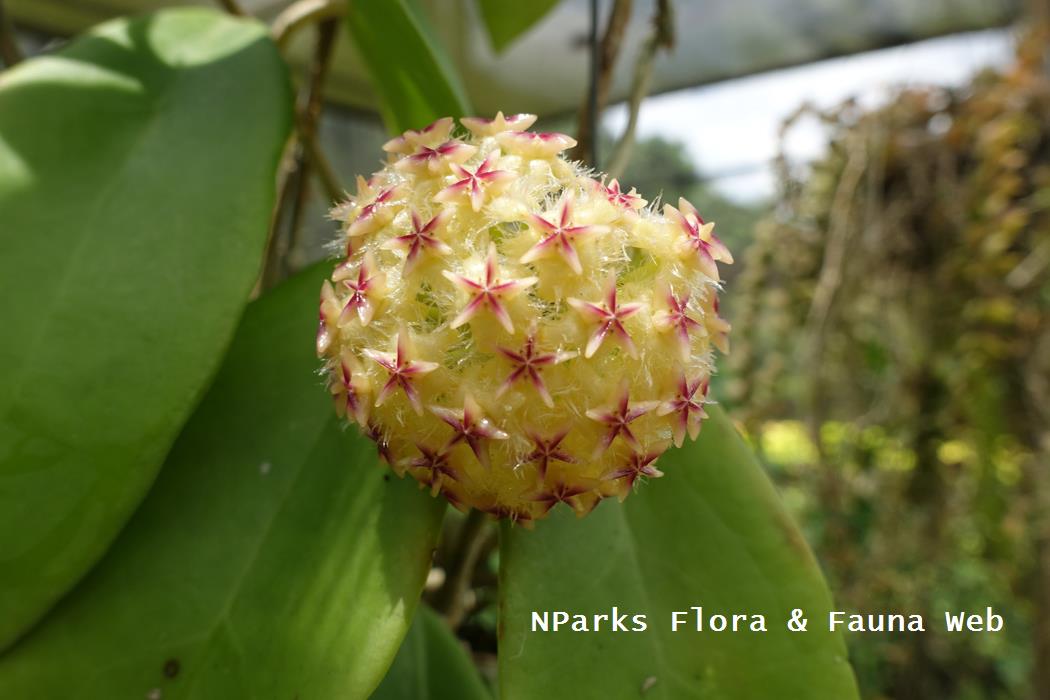
Back
Hoya kerrii Craib
| Family Name: | Apocynaceae |
| Synonyms: | Acokanthera obovata var. kerrii |
| Common Name: | Sweetheart Hoya, Heart-shaped Hoya, Heart Leaf, Valentine Hoya, Valentine Wax Plant, Wax Hearts, 凹叶球兰 |
Sweetheart Hoya (Hoya kerrii) earned its name from its characteristic heart-shaped leaves. This evergreen climber is commonly sold commercially as a single leaf. However, if grown with its stem intact, this slow-growing Hoya can trail and climb across trellises displaying heavy long vines and thick leaves. Generally easy to care for, bunches of star-shaped flowers readily bloom when it receives several hours of bright indirect sunlight daily and it only requires minimal watering.
Name
Classifications and Characteristics
| Plant Division | Angiosperms (Flowering Seed Plants) (Dicotyledon) |
|---|---|
| Plant Growth Form | Climber, Epiphyte |
| Lifespan (in Singapore) | Perennial |
| Mode of Nutrition | Autotrophic |
| Plant Shape | Irregular |
| Maximum Height | 2.4 m to 3 m |
Biogeography
| Native Distribution | Cambodia, Java, Laos, Thailand, Vietnam and Malaya |
|---|---|
| Native Habitat | Terrestrial (Primary Rainforest) |
| Preferred Climate Zone | Tropical |
Description and Ethnobotany
| Growth Form | Tropical epiphyte with succulent leaves and woody stem. It attaches itself to the host tree with aerial roots and a twining growth habit. |
|---|---|
| Roots | Roots will form from the stem nodes. |
| Foliage | Leaves are thick and heart-shaped with opposite leaf arrangement (5 - 15 cm long). The petiole (1 - 2.5 cm long, 0.3 cm wide) is connected to the pointed part of the heart shape. |
| Flowers | Flowers are small, waxy and arranged in inflorescences classifed as umbels (4 - 5 cm wide). An umbel consists of several flowers with floral stalks (called pedicels) that are united at the base to a single stem known as the peduncle. They consist of 2 stacked, star-shaped structures known as the corona and corolla. The corona is on top, smaller than the corolla and is pinkish-brown to purplish-brown. The corolla is mostly white. Flowers are long-lasting and release their fragrance at night. |
| Habitat | Occurs in tropical forests. |
| Cultivation | This species grows slowly. Plant in well-drained, slightly acidic to neutral soil of 1/3 orchid soil mix and 2/3 potting mix (pH 6 - 7.5). Space individuals 7 - 15 cm apart. This species is intolerant of waterlogging, so allow the soil to stay slightly dry. For potted plants, water when the top 3 cm of soil becomes dry. Lightly feed plants every month with a half-diluted general fertilizer. This species will grow and flower best if kept rootbound. Avoid moving the plant when flower buds have formed. Do not remove old floral stalks, as new buds will form from it. They are usually resistant to pests, but monitor them for scale insects and mealy bugs. |
| Etymology | The genus epithet "Hoya" was named after Thomas Hoy, an English gardener of the early 1800s. The specific epithet "kerrii" was named for Arthur Francis George Kerr, a collector in Siam. |
| Ethnobotanical Uses | Others: It is used to treat pus-producing skin ulcers and reduce swelling. |
Landscaping Features
| Landscaping | This slow-growing species is a popular indoor plant. It is placed on window sills, in hanging baskets or trained against small trellises. Children may enjoy growing this species, because it has heart-shaped leaves and is easy to grow. In addition, the green leaves may be decorated by painting designs on the leaf surface. |
|---|---|
| Desirable Plant Features | Ornamental Flowers, Fragrant (Flowers) (Day), Ornamental Foliage |
| Landscape Uses | Suitable for Hanging Baskets, Interiorscape/ Indoor Plant |
| Usage Hazard - Cons | Toxic Upon Ingestion, Irritant - Sap |
Fauna, Pollination and Dispersal
| Pollination Method(s) | Biotic (Fauna) |
|---|
Plant Care and Propagation
| Light Preference | Semi-Shade, [Remarks] (Plant in bright but indirect sunlight. ) |
|---|---|
| Water Preference | Little Water |
| Plant Growth Rate | Slow |
| Rootzone Tolerance | Easy to Grow, Well-Drained Soils |
| Pest(s) | Sucking Insects |
| Propagation Method | Stem Cutting |
| Propagation Ease | Easy |
| Propagation Method Remarks | Propagate by seed, leaf cuttings or herbaceous / woody stem cuttings. Seeds do not store well, so sow them soon after harvesting. |
Foliar
| Foliage Retention | Evergreen |
|---|---|
| Mature Foliage Colour(s) | Green |
| Mature Foliage Texture(s) | Thick |
| Prominent Young Flush Colour(s) | Green |
| Young Flush Texture(s) | Thick |
| Foliar Type | Simple / Unifoliate |
| Foliar Arrangement Along Stem | Opposite |
| Foliar Attachment to Stem | Petiolate |
| Foliar Shape(s) | Non-Palm Foliage (Cordate) |
| Foliar Margin | Entire |
| Foliar Apex - Tip | Emarginate |
| Foliar Base | Acute |
Floral (Angiosperm)
| Flower Colour(s) | Brown, White |
|---|---|
| Flower Texture(s) | Velvety / Furry / Tomentose |
| Flower Grouping | Cluster / Inflorescence |
Image Repository
Others
| Master ID | 118 |
|---|---|
| Species ID | 1414 |
| Flora Disclaimer | The information in this website has been compiled from reliable sources, such as reference works on medicinal plants. It is not a substitute for medical advice or treatment and NParks does not purport to provide any medical advice. Readers should always consult his/her physician before using or consuming a plant for medicinal purposes. |








